Have you ever found yourself lost in a website’s hierarchy, wondering how to return to the main page or the category you were browsing before?
It’s a frustrating experience that can lead to user abandonment and lower engagement rates. This is where breadcrumbs come into play.
Breadcrumbs are a simple yet effective way to improve user experience by providing clear and concise navigation cues. These handy navigation aids not only help visitors find their way around your site, but they can also positively impact your website’s SEO.
By displaying a trail of links that shows users exactly where they are in a website’s hierarchy, breadcrumbs make it easy for users to retrace their steps and find the information they’re looking for.
In this article, we’ll explore breadcrumbs, the importance of breadcrumbs in website design, and how they can benefit both users and the website’s SEO.
What are Breadcrumbs?
Breadcrumbs are a type of navigation aid that helps website visitors keep track of where they are on a website and easily move back and forth between pages.
The name “Breadcrumbs” came from the story of Hansel and Gretel, where the children drop breadcrumbs along their path so they can find their way back home.
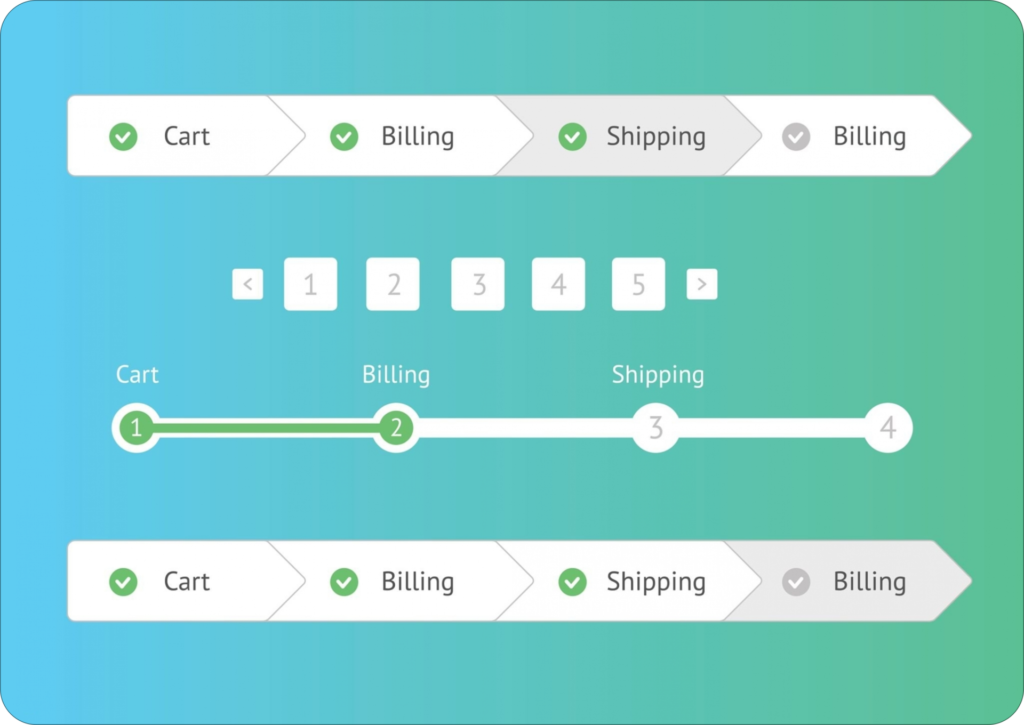
On a website, breadcrumbs typically appear at the top of a page and show visitors the path they took to get there.
For example, if a visitor starts on the homepage and clicks on “Products” and then “Shoes,” the breadcrumb trail might look like this:
Home > Products > ShoesBreadcrumbs serve two main purposes: they help visitors understand the structure of the website and how different pages are related, and they make it easy for visitors to move back and forth between pages without getting lost.
In addition to improving the user experience, breadcrumbs can also have a positive impact on SEO.
By making it easy for search engines to understand the structure of your website and how different pages are related, breadcrumbs can help search engines crawl and index your site more efficiently, which can improve your search rankings.
Breadcrumbs aren’t just limited to websites as they can also be found in operating systems like Windows. Microsoft introduced breadcrumbs in Windows Vista, and since then, they have become a standard feature in all subsequent Windows editions.

Breadcrumbs in Windows work similarly to their website counterparts by allowing users to quickly navigate to previous folders or locations in the operating system. So, breadcrumbs are not just useful for websites but also for navigating file systems and directories on a computer.
Different Types of Breadcrumbs
There are three main types of breadcrumbs that you can use on your website:
- Location-based breadcrumbs
- Attribute-based breadcrumbs
- History-based breadcrumbs
Each type serves a slightly different purpose, but they all help visitors understand where they are on your website and how to navigate to other pages.
Location-Based Breadcrumbs
Location-based breadcrumbs are a type of navigation aid that shows website visitors the path to get to the current page. This type of breadcrumb is helpful for websites with a clear page hierarchy, such as e-commerce sites with categories and subcategories of products.
The purpose of location-based breadcrumbs is to help visitors understand the structure of the website and how different pages are related. By showing visitors the path they took to get to the current page, they can easily navigate back to previous pages if needed.
For example, let’s say you’re shopping for shoes on H&M. You start on the homepage and click on the “Men” category. From there, you click on “Sportswear,” then on “Shorts,” and then “Windproof Double-layer Running Shorts.”
The location-based breadcrumb trail at the top of the page might look something like this:
Home > Men > Sportswear > Shorts > Windproof Double-layer Running ShortsThis breadcrumb trail shows you the path you took to get to the current page, starting from the homepage and going through the “Men” category, the “Sportswear” subcategory, then again subcategory “Shorts,” and finally the “Windproof Double-layer Running Shorts” page.
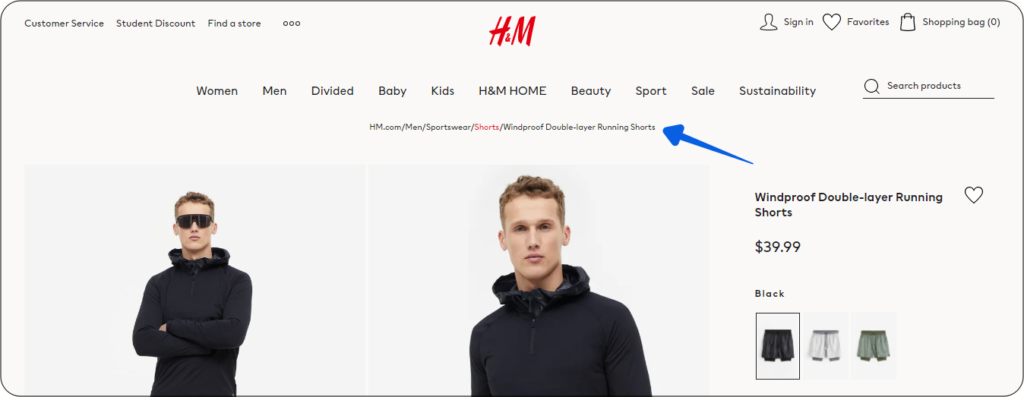
If you wanted to go back to the “Shorts” subcategory, you could simply click on that part of the breadcrumb trail, and you’d be taken there.
Attribute-Based Breadcrumbs
Attribute-based breadcrumbs are a type of navigation aid that show website visitors the characteristics of the product or content they are viewing. This type of breadcrumb is useful for websites with many products or pieces of content that can be filtered by different attributes, such as size, color, or date.
The purpose of attribute-based breadcrumbs is to help visitors understand the attributes of the product or content they are viewing and make it easy for them to navigate to similar products or content. By showing visitors the attributes of the product or content, they can easily navigate to other products or content with similar attributes.
For example, you want to buy a laptop on Office Depot. You could start from “Home” and click on the category “Computer Accessories” and then on the subcategory “Laptop Computers.” From there, you filter the results to show only “HP Laptops” with a price range of “$500 – $1000” and with a “Silver” color.
The attribute-based breadcrumb trail at the top of the page might look something like this:
Home / Computers & Accessories / Laptop Computers / HP $500 - $1000 / SilverThis breadcrumb trail shows you the attribute of the laptop you’re viewing, starting with the category “Computer & Accessories” and then “Laptop Computers,” with the price ranging from “$500 – $1000,” having “Silver” color.
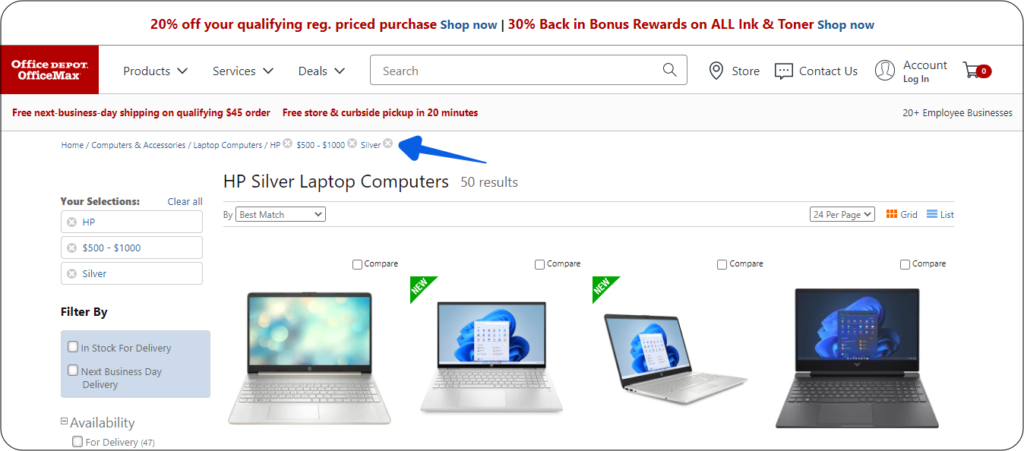
If you want to view different colors or price ranges, you can use the breadcrumbs to go back and select any other color or price range.
History-Based Breadcrumbs
History-based breadcrumbs are a type of navigation aid that show website visitors the pages they visited in the current browsing session. This type of breadcrumb is useful for websites that have a lot of content or products and where visitors may want to retrace their steps to find something they previously viewed.
History-based breadcrumbs help visitors keep track of the pages they have visited and make it easy for them to navigate back to a previous page if needed. By showing visitors their browsing history, they can easily retrace their steps and find the information they seek.
For example, you’re browsing a news website and reading an interesting article about politics. You then click on a link to a related article about economics but decide that you want to go back to the politics article.
The history-based breadcrumb trail at the top of the page might look something like this:
Home > Politics > Economics > Politics.This breadcrumb trail shows you the pages you visited in the current browsing session, starting with the homepage and then showing the sequence of pages you visited, with the most recent page at the end.
If you wanted to go back to the politics article, you could simply click on the “Politics” part of the breadcrumb trail, and you’d be taken back to that article.
Benefits of Using Breadcrumbs on Your Website
Using breadcrumbs on your website can provide many benefits for both your visitors and your business.
Below are a few benefits of using breadcrumbs:
1. Breadcrumbs Will Help Improve User Experience
Breadcrumbs can help improve the user experience on your website by making it easier for visitors to navigate and find the content they are looking for. Breadcrumbs show visitors the path they have taken to arrive at a particular page and can help them understand how the content on your website is organized.
2. Breadcrumbs Can Reduce The Bounce Rates
Breadcrumbs can help reduce bounce rates on your website by providing visitors with a clear path to follow if they arrive on a page that isn’t relevant to their interests. By following the breadcrumb trail, visitors can quickly find their way back to a page that is more relevant to their interests, reducing the likelihood that they will leave your website without finding what they are looking for.
3. They Can Help Boost Your Website’s SEO
Breadcrumbs can also have a positive impact on your website’s SEO by helping search engines understand the structure and organization of your website. Breadcrumbs can provide additional context and information about the content on your website, which can help search engines index and rank your pages more effectively.
4. They Can Increase Your Click-Through Rates
Breadcrumbs can increase click-through rates on your website by making it easier for visitors to find related content and navigate to pages that are relevant to their interests. By following the breadcrumb trail, visitors can quickly discover new content and explore more of your website.
5. Breadcrumbs Can Provide Better Accessibility
Breadcrumbs can improve accessibility on your website by providing an additional navigation aid for visitors who may have difficulty navigating your site. Breadcrumbs can help these visitors understand the structure and organization of your website and make it easier for them to find the content they are looking for.
How To Add Breadcrumbs To Your Website?
Adding breadcrumbs to your website can help improve navigation and make it easier for visitors to find the content they want.
Here’s how you can add breadcrumbs to your website:
1. Yoast SEO
Yoast SEO is a popular WordPress plugin for SEO that also includes a built-in breadcrumb feature. Here’s how to add breadcrumbs using Yoast SEO Plugin:
- Install and activate the Yoast SEO plugin on your WordPress site.
- Go to the Yoast SEO dashboard and click the “Settings” tab.
- After that, scroll down until you find the “Advanced” tab. Click on it, and a dropdown menu will be opened. From there, click on breadcrumbs.
- Choose a breadcrumb separator that fits your website’s design.
- Customize the breadcrumb settings to match your website’s structure and content.
- Save your changes and check to make sure your breadcrumbs are working properly.
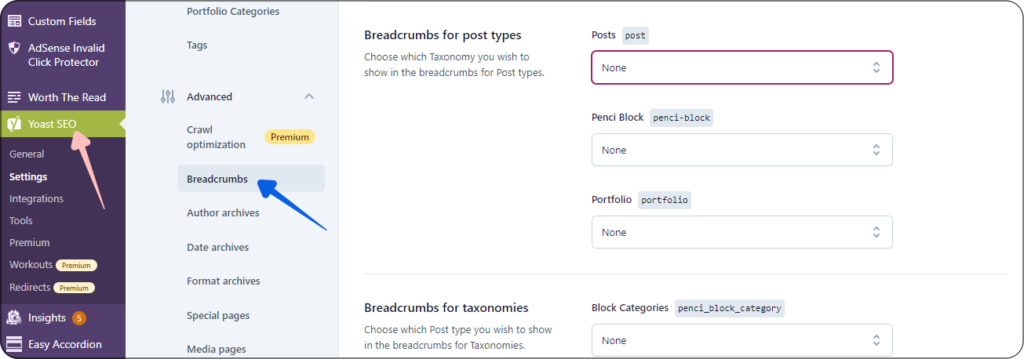
2. Breadcrumb NavXT
If you prefer to use a breadcrumb plugin other than Yoast SEO, you can try Breadcrumb NavXT. Here are the steps to add breadcrumbs to your website using this plugin:
- Go to your WordPress dashboard and click on “Plugins.”
- Click on “Add New” and search for “Breadcrumb NavXT.”
- Choose the “Breadcrumb NavXT” plugin and click “Install Now.”
- Activate the plugin.
- Customize the plugin settings according to your website’s structure and content.
- Save your changes and check to ensure that the breadcrumbs are working correctly.
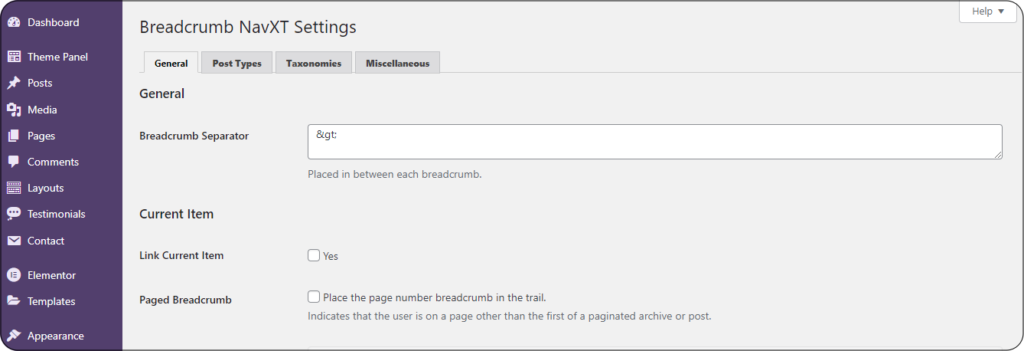
3. WooCommerce Plugin
If you’re running an online store using the WooCommerce plugin, you can use the WooCommerce built-in Breadcrumb feature to add breadcrumbs to your website.
Here’s how to add breadcrumbs to your WooCommerce site using the built-in functionality:
- Go to your WordPress dashboard and click on “Plugins.”
- Click on “Add New” and search for “WooCommerce Breadcrumb.”
- Choose the “WooCommerce Breadcrumb” plugin and click “Install Now.”
- Activate the plugin.
- Customize the plugin settings according to your website’s structure and content.
- Save your changes and check to ensure that the breadcrumbs are working correctly.
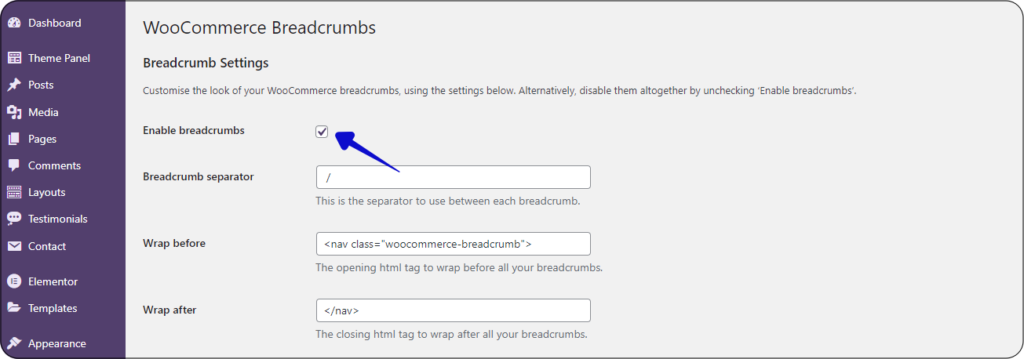
Conclusion
Breadcrumbs are a great way to improve user navigation on your website and help visitors understand your site structure.
Using breadcrumbs, visitors can easily find their way back to the homepage or other relevant pages.
Not only do breadcrumbs benefit visitors, but they also benefit SEO as search engines like Google appreciate the clear structure they provide.
